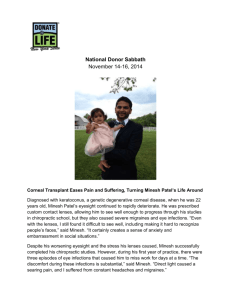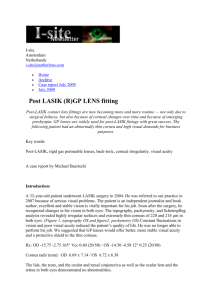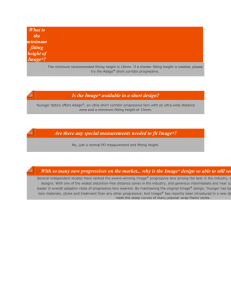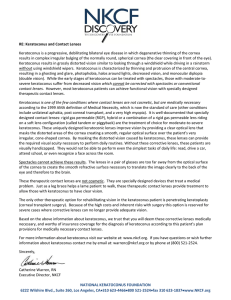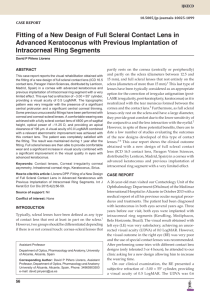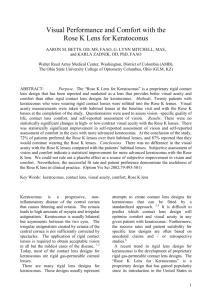Abstract for EAOO 2014 poster
advertisement
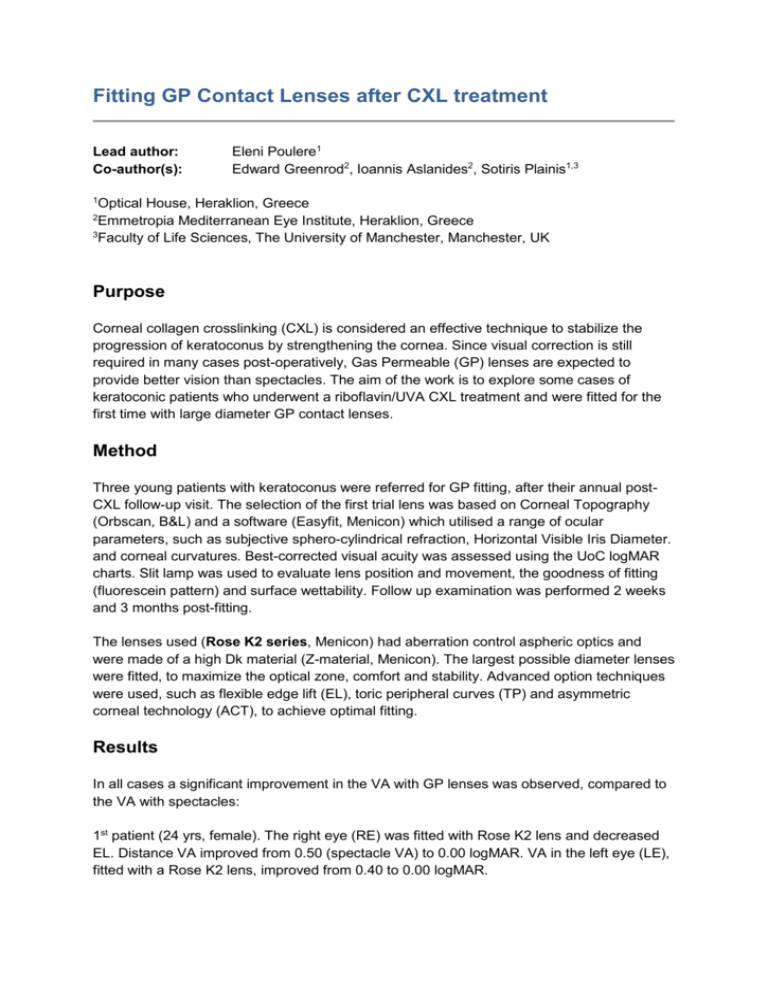
Fitting GP Contact Lenses after CXL treatment Lead author: Co-author(s): Eleni Poulere1 Edward Greenrod2, Ioannis Aslanides2, Sotiris Plainis1,3 1 Optical House, Heraklion, Greece Emmetropia Mediterranean Eye Institute, Heraklion, Greece 3 Faculty of Life Sciences, The University of Manchester, Manchester, UK 2 Purpose Corneal collagen crosslinking (CXL) is considered an effective technique to stabilize the progression of keratoconus by strengthening the cornea. Since visual correction is still required in many cases post-operatively, Gas Permeable (GP) lenses are expected to provide better vision than spectacles. The aim of the work is to explore some cases of keratoconic patients who underwent a riboflavin/UVA CXL treatment and were fitted for the first time with large diameter GP contact lenses. Method Three young patients with keratoconus were referred for GP fitting, after their annual postCXL follow-up visit. The selection of the first trial lens was based on Corneal Topography (Orbscan, B&L) and a software (Easyfit, Menicon) which utilised a range of ocular parameters, such as subjective sphero-cylindrical refraction, Horizontal Visible Iris Diameter. and corneal curvatures. Best-corrected visual acuity was assessed using the UoC logMAR charts. Slit lamp was used to evaluate lens position and movement, the goodness of fitting (fluorescein pattern) and surface wettability. Follow up examination was performed 2 weeks and 3 months post-fitting. The lenses used (Rose K2 series, Menicon) had aberration control aspheric optics and were made of a high Dk material (Z-material, Menicon). The largest possible diameter lenses were fitted, to maximize the optical zone, comfort and stability. Advanced option techniques were used, such as flexible edge lift (EL), toric peripheral curves (TP) and asymmetric corneal technology (ACT), to achieve optimal fitting. Results In all cases a significant improvement in the VA with GP lenses was observed, compared to the VA with spectacles: 1st patient (24 yrs, female). The right eye (RE) was fitted with Rose K2 lens and decreased EL. Distance VA improved from 0.50 (spectacle VA) to 0.00 logMAR. VA in the left eye (LE), fitted with a Rose K2 lens, improved from 0.40 to 0.00 logMAR. 2nd patient (24yrs, male). His RE was in no need for correction. A Rose K2 lens (BC:7.00, Dia:10.30) was fitted, improving the VA from 0.70 to 0.50 logMAR, eliminating also the high exophoria (16Δ) when uncorrected. 3rd patient (24yrs, male). His RE was in no need for correction. VA in the LE, fitted with a Rose K2 IC (of reverse geometry), improved from 0.40 to -0.10 logMAR, After 3 months of use, there were no adverse effects on the cornea while all patients showed compliance. They managed to wear their CLs for almost 10 hours per day, reporting no complaints. Conclusion GP contact lenses may be the treatment of choice after CXL treatment in keratoconus. Thorough knowledge of lens designs, new geometries and advanced option techniques are essential for a non-apical contact fitting in these irregular and “less-flexible” corneas. As lens location and movement form the main difficulties in fitting, large diameter or reverse geometry GP lenses usually provide the best option.
